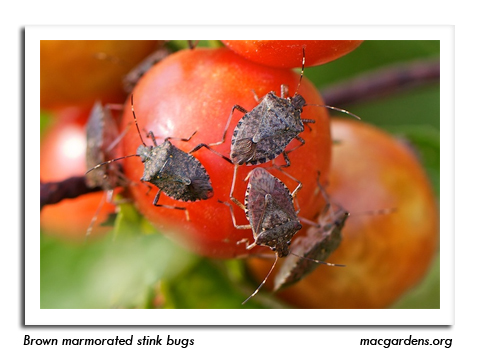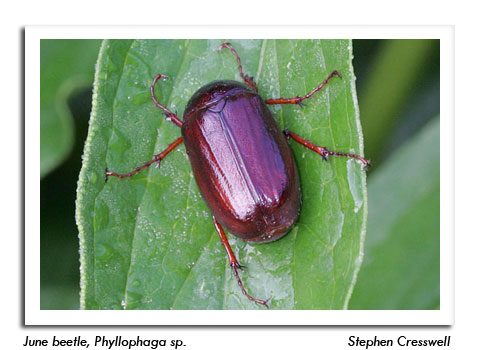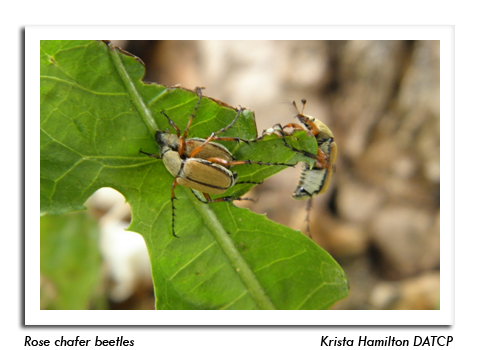
 |
|
|
Fruits
Volume 63 Number 18 Date 11/15/2018 CODLING MOTH - The earliest moths were trapped on May 17, and most monitoring sites established a spring biofix from May 20-26. Record-setting late May heat caused a heavy, compressed emergence, with very large flights of 30-70 moths reported from several orchards. Treatments targeting first-generation larvae began by June 7 but were complicated by rain. Flights declined around the end of the month. Summer emergence began by mid-July and unusually large counts (15-45 moths) continued throughout August. The high summer codling moth pressure was an indicator of the ineffective spring generation control due to rain diluting larvicide coverage during the early June treatment window. Codling moth flights continued into early September, and additional late-season spot treatments were required for several orchards. BROWN MARMORATED STINK BUG - Monitoring by DATCP cooperators and IPM Institute consultants in 39 orchards and 12 vineyards resulted in the capture of BMSB on traps at six sites. All clear sticky panels collected fewer than 20 total specimens during the late June through October survey period. However, in Janesville, another trap type--the dual funnel trap from Great Lakes IPM--captured 258 BMSB (173 adults and 85 nymphs). Rock County is one of several counties (along with Dane, Milwaukee, Outagamie, Waukesha, and Winnebago) where concentrations are high enough that BMSB has become an urban nuisance. The majority of range expansion this year occurred in western Wisconsin, particularly in Eau Claire, Jackson, La Crosse, Marquette, Richland and Trempealeau counties. Twenty-seven of the state's 72 counties are now known to be infested with BMSB. JUNE BEETLE - Localized heavy June beetle populations were noted in southern Wisconsin in spring. According to one report from the Boscobel area of Grant County, the beetles severely defoliated young oaks and fruit trees, causing complete loss of the first flush of leaves. The largest numbers were observed during the latter half of May into June. SPOTTED WING DROSOPHILA - The first SWD flies of the season were captured in UW traps on June 1 in Dane County. This date compares to June 5 in 2017, and June 10 in 2016, and suggests that SWD are appearing earlier each year. Significant SWD fly captures were first reported during the week of June 17-23 at monitoring sites, and larvae were common in raspberries and other small fruits by early July. BLUEBERRY MAGGOT - A fourth season of survey work to determine the distribution of the blueberry maggot in Wisconsin resulted in no additional detections. A new state record was established in 2016 when adult flies were collected for the first time in Adams and Sauk counties. This year's survey consisted of yellow sticky traps set at eight sites in five counties. The ammonium acetate-enhanced traps were placed in wild and cultivated blueberries and checked every three weeks in July and August. No flies were captured. Currently the blueberry maggot fly is known only from Adams and Sauk counties in central Wisconsin and it remains unclear if the species occurs more widely in the state. APPLE MAGGOT - Emergence of flies began in orchards by June 27. Counts were mostly low for much of the summer, with the largest trap captures documented during the week of July 26-August 1. The season's high count of 22 flies on a red sphere trap was reported from Crawford County. SPOTTED LANTERNFLY - Surveys for this pest in nine Wisconsin apple orchards and 12 vineyards were negative in 2018. Spotted lanternfly has not yet been found in the state. ROSE CHAFER - High populations of this generalist pest appeared in mid-June in vineyards and orchards, where the beetles skeletonized leaves and damaged developing fruit clusters. Reports of minor damage to grapes, raspberries, strawberries, fruit trees, and landscape plants were common. Chafer feeding subsided in most areas by mid-July. -- Krista Hamilton, DATCP Entomologist APIARY INSPECTION - Apiary inspectors visited 200 beekeepers this year, opening 3,342 hives for inspection. Based on these voluntary inspections, winter mortality decreased from 54% in 2016-17 to 47% in 2017-18, which is slightly higher than the 40% national average winter loss for beekeepers during the same time period. Varroa mite was detected in 58% of hives sampled for this pest, compared with 64% last season. Other pests and diseases found include American foulbrood in 0.1% of hives, chalkbrood in 1.1% of hives, European foulbrood in 0.3%, deformed wing virus in 1.2%, sacbrood in 1.4%, and small hive beetle in 1.7% of hives. Pest and disease issues were generally down this year, although frequent rain interrupted inspection schedules. Also due to the persistent wet weather, there were more broodless periods this spring, resulting in lower mite populations. Inspectors issued 71 apiary inspection certificates for 31,240 migratory hives, primarily destined for California, Florida and Texas to be used for pollination services. -- Liz Meils, DATCP Nursery Inspector NON-NATIVE AMBROSIA BEETLES - The non-native ambrosia beetle species Anisandrus maiche was detected for a second year in honey locust liners at a Wisconsin nursery, with infested plant stock found in Ozaukee and Washington counties in 2017 and 2018, respectively. In addition to nursery detections, this beetle has been identified in trap bycatch from exotic woodborer and bark beetle surveys since 2016--over 400 specimens have been collected across 10 southeastern counties and in Brown County (see map below). Although DATCP has been tracking non-native ambrosia beetles through trap bycatch since 2013, this was the first year a targeted survey was conducted in five Wisconsin nurseries. Besides A. maiche, the non-native black stem borer, Xylosandrus germanus, and Xyleborinus saxesenii were also collected at the Ozaukee County nursery. The granulate ambrosia beetle, Xylosandrus crassiusculus, was not found this season, but this species had previously been found at a sawmill in 2013. Infestations of X. germanus, X. crassiusculus and A. maiche are still limited, while X. saxesenii has been detected statewide. Properly-timed trunk sprays are the standard treatment for protecting vulnerable plant stock from ambrosia beetles. -- Renee Pinski, DATCP Forest Entomologist 





|
|
|